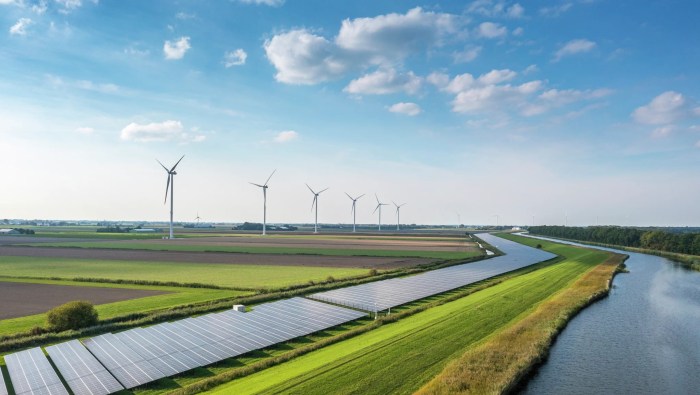Renewable energy insurance is the key to protecting green energy initiatives in today’s dynamic landscape. From solar to wind power, understanding the ins and outs of insurance coverage is crucial for the success of renewable projects.
Exploring the various types of coverage, factors influencing premiums, the claims process, and the latest trends in renewable energy insurance paints a comprehensive picture of this vital sector.
Overview of Renewable Energy Insurance
Renewable energy insurance provides coverage for risks associated with renewable energy projects, such as solar, wind, hydro, and geothermal power generation. It helps protect investors, developers, and operators from financial losses due to unforeseen events.
Importance of Renewable Energy Insurance
Renewable energy insurance plays a crucial role in the energy sector by providing financial security and risk mitigation for renewable energy projects. It encourages investment in clean energy technologies by offering protection against potential losses, such as equipment failure, natural disasters, or project delays.
- It safeguards investments: Renewable energy projects require significant capital investment, and insurance helps protect these investments by covering losses that could otherwise derail the project.
- It promotes project sustainability: By mitigating risks, renewable energy insurance ensures the long-term viability and success of clean energy projects, contributing to a more sustainable energy future.
- It fosters growth in the renewable energy sector: Insurance coverage gives investors and stakeholders confidence in the stability and reliability of renewable energy projects, leading to increased funding and expansion of the sector.
Examples of Renewable Energy Sources Covered by Insurance Policies
Renewable energy insurance policies typically cover a wide range of clean energy sources, including:
- Solar power: Insurance for solar photovoltaic (PV) systems, solar farms, and solar thermal projects.
- Wind power: Coverage for onshore and offshore wind farms, wind turbines, and wind energy installations.
- Hydropower: Insurance for hydroelectric dams, run-of-the-river projects, and tidal energy facilities.
- Geothermal energy: Coverage for geothermal power plants and geothermal heating systems.
Types of Coverage in Renewable Energy Insurance

Renewable energy insurance offers various types of coverage to protect projects and investments in the renewable energy sector. Let’s explore the different categories of coverage available in renewable energy insurance.
Property Damage Coverage
Property damage coverage in renewable energy insurance helps protect against physical damage to renewable energy assets such as solar panels, wind turbines, and other equipment. This coverage can include events like natural disasters, fires, vandalism, and equipment failure. It is essential for ensuring the financial security of renewable energy projects in case of unexpected damage.
Business Interruption Coverage
Business interruption coverage is another crucial aspect of renewable energy insurance. This coverage helps offset the financial losses incurred when a renewable energy project is unable to operate due to a covered event. It can include lost revenue, ongoing expenses, and additional costs incurred during the downtime. Business interruption coverage is vital for maintaining the financial stability of renewable energy projects during unforeseen disruptions.
Liability Coverage
Liability coverage is significant for renewable energy projects as it protects against third-party claims for bodily injury or property damage caused by the project. This coverage can help cover legal fees, settlements, and judgments in case of lawsuits. Liability coverage is essential for safeguarding renewable energy developers, operators, and investors from potential financial liabilities arising from accidents or incidents related to the project.
Factors Influencing Renewable Energy Insurance Premiums
When it comes to renewable energy insurance premiums, several key factors come into play that can impact the cost. Understanding these factors is crucial for renewable energy project developers and investors looking to protect their investments effectively.
Location of Renewable Energy Projects
The location of renewable energy projects plays a significant role in determining insurance rates. Projects situated in areas prone to natural disasters such as hurricanes, earthquakes, or floods may face higher insurance premiums due to the increased risk of damage. Additionally, projects located in regions with unstable political climates or inadequate infrastructure may also see higher insurance costs.
Role of Technology and Equipment
The technology and equipment used in renewable energy projects also influence insurance premiums. Cutting-edge technologies or specialized equipment may be more expensive to insure due to the higher costs associated with repairs or replacements. Additionally, the age and condition of the equipment can impact premiums, as older or poorly maintained equipment may be more prone to failure or damage.
Claims Process in Renewable Energy Insurance

When it comes to filing a claim for renewable energy insurance, there are specific steps that need to be followed. From assessing damages to resolving claims and compensating for renewable energy projects, the process is crucial for ensuring the protection and sustainability of these projects.
Assessment of Damages
- The assessment of damages in renewable energy insurance claims involves a thorough investigation to determine the extent of the loss or damage.
- Specialized adjusters may be involved to assess the impact on the renewable energy project and calculate the financial repercussions.
- The assessment process may include evaluating the equipment, property, and potential revenue losses to accurately determine the damages.
Resolution of Claims and Compensation
- Once the assessment of damages is complete, the resolution of claims begins, where the insurance company and the policyholder work towards a fair settlement.
- Compensation for renewable energy projects may include repairs, replacements, or financial payouts to cover the losses incurred due to the insured event.
- The compensation process aims to restore the renewable energy project to its pre-damaged state and ensure the continuity of operations.
Trends and Innovations in Renewable Energy Insurance
Renewable energy insurance is constantly evolving to keep pace with the dynamic landscape of the industry. Let’s delve into some of the trends and innovations that are shaping the future of renewable energy insurance.
Parametric Insurance for Renewable Energy Projects
Parametric insurance is gaining traction in the renewable energy sector as a cutting-edge risk management tool. Unlike traditional insurance, parametric insurance pays out a pre-determined amount based on specific parameters, such as wind speed or sunlight levels, without the need for a lengthy claims process. This innovative approach helps renewable energy projects mitigate risks more effectively and ensures quicker recovery in case of unexpected events.
Tailored Products for Emerging Technologies
With the rapid advancements in renewable energy technologies, insurance providers are developing tailored products to address the unique risks associated with emerging technologies like solar panels, wind turbines, and energy storage systems. These specialized insurance solutions offer comprehensive coverage and support the growth of innovative renewable energy projects by providing financial protection against technological failures, performance issues, and other industry-specific risks.
Integration of Data Analytics and AI
Data analytics and artificial intelligence (AI) are revolutionizing the way renewable energy insurance is underwritten, priced, and managed. By leveraging advanced analytics tools, insurers can assess risks more accurately, customize insurance policies based on real-time data, and improve claims processing efficiency. The integration of data analytics and AI enables insurance companies to provide tailored solutions that meet the evolving needs of renewable energy developers and investors.
Collaboration with Renewable Energy Stakeholders, Renewable energy insurance
Insurance providers are increasingly collaborating with renewable energy stakeholders, including project developers, investors, and regulatory bodies, to enhance risk management strategies and promote sustainable growth in the industry. By fostering partnerships and sharing industry insights, insurers can better understand the specific challenges faced by renewable energy projects and develop innovative insurance solutions that address these challenges effectively. This collaborative approach ensures that insurance products remain relevant and responsive to the changing needs of the renewable energy sector.